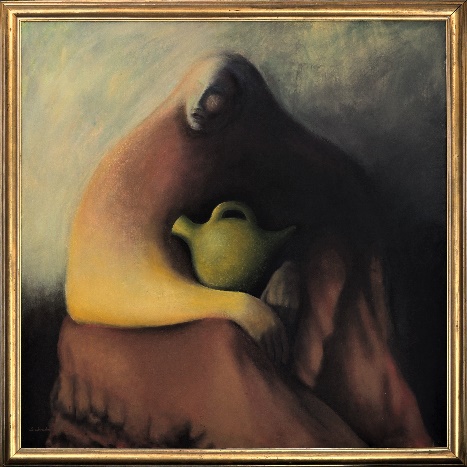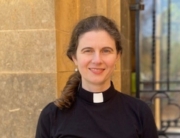
SYMBOLS OF WOMEN
[John 4: 1-15]
A sermon by The Rev’d Dr Lynn Arnold AO
May the words of my mouth and the meditations of our hearts be worthy in your sight, O Lord, our rock and our redeemer. Amen.
Our Gospel reading this evening is about the encounter of Jesus and the Samaritan women at the village well in Sychar. It is a narrative of great significance containing much for us to think about. The reading is not just about another uncomfortable Samaritan intrusion into Jewish certainties in the time of Jesus, but also a challenge to general community attitudes of the day. Regarding the Samaritan, here was Jesus once again using the detested Other to make a point to the chosen Us; while on community attitude side, there was an offence to stereotypes of the time regarding the right ordering of gender, relationship and social place – a woman going alone to the village well in the middle of the day and then engaging in conversation with a man unknown to her and, what’s more, a man of the detested Other to her own people. For his part, Jesus was a willing accomplice to all this intrusion and challenge; firstly, he had not avoided this divorced woman who by then lived with a man to whom she was not married; then he had asked for a drink of water from her using what would have been a ritually unclean bucket, Samaritan as it was; and to cap it all he had actually discussed theology with the woman,. All this was more than scandalous, it was just wrong by all the mores of the time; it should hardly surprise us that the gospel writer recorded the astonishment of the disciples; verse 27 of the same chapter from John’s Gospel has this:
The disciples were marvelling that Jesus was talking with a woman.
This story is one of a few in which women play a significant role in the Gospels; at first thinking, we might be of the view that there are not many such stories. A didactic polemic might suggest that this is the result of these four seminal documents about Jesus having all been written by men. After all, few women in the Gospel stories are ever named – of course, there were women such as Mary, Jesus’ mother, the sisters Mary and Martha, Mary Magdalene, Joanna, Susanna and Herod’s sister-in-law Herodias amongst others; but for the most part the women of the Gospels seemed to have been intentionally left without names; by way of example, take these verses from Matthew:
… aren’t (Jesus’) brothers James, Joseph, Simon and Judas (and) aren’t all his sisters with us? [Matt 13:55-56]
At other times they weren’t even counted – recall how the story of the miracle of the loaves and fishes dealt with the women who were present:
The number of those who ate was about five thousand men … besides women and children [Matt 14:21]
But such an approach wouldn’t really be fair. It is true that, in terms of people contemporary with Jesus, the Gospels contain the names of twice as many men as women [23 vs 11], and there might seem to be fewer stories involving women in those same books. However, when they treated with women, named or unnamed, the Gospels did so with extraordinary significance. Dr Mary Ann Getty, author of The Women of the Gospels, makes this point:
Mention of the presence, role, and support of women is something of a surprise in the patriarchal world of the New Testament. But the fact that they are there challenges us to understand that, without them, the Gospel as we know it could not have been told.
It has also been noted that the presence of women in Gospel narratives exceeds their presence in other literature of the age.
So what should we take from such stories today? Ignore them because we have addressed issues of gender inequality and now fully appreciate the role of women in our world? Let me relate an encounter I had when I was being considered for the role of CEO of World Vision Australia.
Back in late 1996 I had been shortlisted for the position and found myself before the full board to be grilled by them. Most of the questions they asked were predictable and were easily answered; one, however, caught me by surprise. I was asked what my attitude was to women in ministry. As I say, it caught me by surprise but I had no trouble answering it. I started by going back to my childhood when we lived in Canada for nearly five years back in the 1950s; it was a time not only when I started primary (or elementary) school, but also when I first attended Sunday School. I went to the Children’s Church of the Victoria Truth Centre in British Columbia, and it was there that some important foundations were laid to developing of my theological perspectives over subsequent decades. I learnt there of the importance of ‘Living Life Lovingly’ – the credo of the Children’s Church; I learnt of the damage done by the world’s easy attribution of guilt onto the backs of others; and I learnt about the positive power of Hope in the divine sense, not the world’s. Yes, that church has remained enormously influential for me, to the extent that I have never forgotten its minister, Rev Emma Smiley.
Emma Smiley, who I would come to consider as my third grandmother, was the punch-line to my answer to the strange question I had been asked. For I went on to say that my experience at the tender age of five of her ministry had meant I had never understood the argument against the ordination of women. It was then my turn to ask a question of the board; which was: ‘why did you ask me such a question?’
Their answer was that World Vision Australia didn’t actually have a position on the important question, which was then still quite current with the Anglican Church of Australia having more or less only resolved its position three years previously. So they really didn’t care what camp I was in on that theological battlefront; however, what they had wanted to ascertain was my attitude to women in the process of societal change. World Vision experience, they told me, over many years had been that women were the primary agents of change in the areas where the organisation worked and they didn’t want to appoint a CEO who had a problem with that. More importantly, they were also telling me, to paraphrase Mary Ann Getty’s words that:
to understand that, without women, (the development story) as we know it could not have been told.
Over the centuries there has been a problem not only with the way that many have interpreted the role of women in the Bible let alone the broader society, but also with the roles they played and the stories that they could have told. Take the case of the woman Junia for example whom Paul considered to be an apostle – [Romans 16:7]; by the third century however, the woman Junia had been airbrushed out and replaced with a man, now called Junias.
So let us return to a consideration of women in the Gospels. Consider these points: there were three incidents where Jesus raised people from the dead, in two of them, the dead were restored to women (Lazarus to Mary and Martha [John 11:1-44]; and the only son to the unnamed widow of Nain [Luke 7:11-17]). Then there were the women who were important supports for Jesus’ ministry, such as Mary Magdalene, Susanna and Joanna, wife of the manager of Herod’s household, who we are told:
Were helping to support (Jesus and the disciples) out of their own means. [Luke 8:1-3]
Perhaps more significantly, in his ministry Jesus reached out to women at the margin. Gilbert Bilezikian, in Beyond Sex Roles, has written of these women whom he describes as:
negligible entities destined to exist on the fringes of life
saying that Jesus:
thrusts them on centre stage in the drama of redemption with the spotlights of eternity beaming down upon them, and He immortalises them in sacred history.
Consider the woman who touched Jesus’ garment [Mark 5:25-34], the woman bent double [Luke 13:10-17] and the offering of the poor widow [Mark 12:41-44], as examples of such unnamed women whom Jesus thrust onto the centre stage of sacred history for us never to forget.
Finally there is the bookending role of women in the earthly life of Jesus: he was born of a woman, Mary, and it would be women (many according to Matthew 27:55) who would be there at the Crucifixion; while on the following Sunday it would be left to three women who would be the first to witness that Jesus had risen. As Catherine Kroeger has put it:
Women were the last disciples at the cross and the first at the empty tomb.
Tonight, after Evensong, you are all invited to participate in the opening of “Symbols of Women”, an exhibition of paintings by the artist Salvador Loreto. You can see the thirteen paintings on display on the left-hand side wall of the Cathedral. In the program for the exhibition there appears this description:
Coming from Spain, a country which reveres women, particularly the mother, Loreto’s work symbolises his love, respect and admiration for women, acknowledging their beauty, strength and spirituality …
I have already had the chance to spend time with these works which will be on display for the next week. They are deeply moving for, while they may seem shrouded in namelessness, they seem to speak of women through all time – not just the Spain of Salvador’s youth, nor even the world of Biblical times, but of our time as well. As you reflect on the paintings, I ask you to think first about what stories the women portrayed might have told in the seeming first century setting of the paintings, and then in our own context today.
Theologians and historians alike have come to acknowledge in recent decades just how significant women were to the early church. Their numbers were certainly larger than the men, attracted as they were by the equality they received there and by the banning of such pagan practices as female infanticide. But they also came because they could fulfil roles beyond the societal expectations of the day. I have mentioned Junia, however she was not the only female church leader of the time – Biblical records speak of Priscilla, Chloe, Lydia, Apphia and Nympha as having been house church leaders; nor indeed was she the first.
Our Gospel reading tonight did not name the Samaritan woman at the village well, but Orthodox tradition has it that she was called Photine which meant ‘the luminous one’ for she did indeed become a light to others – listen to the words she said after the encounter with Jesus to her fellow townspeople:
Then leaving her water jar, the woman went back to the town and said to her people: ‘Come, see a man who told me everything I ever did. Could this be the Christ?’ [v29]
Thus, according to John’s narrative, the Samaritan woman at the well became the first evangelist. Returning to the quote from Mary Ann Getty which I cited earlier, what are we to make of her point that:
without (women), the Gospel as we know it could not have been told.
Getty was writing about the first century, with the point being that without narratives such as that about the meeting of Jesus with Photine, we would not have the Gospel that we do. More than that, given that Scripture is a living word, we are invited to consider how that story keeps on being told in ways that may surprise us in our context today.



